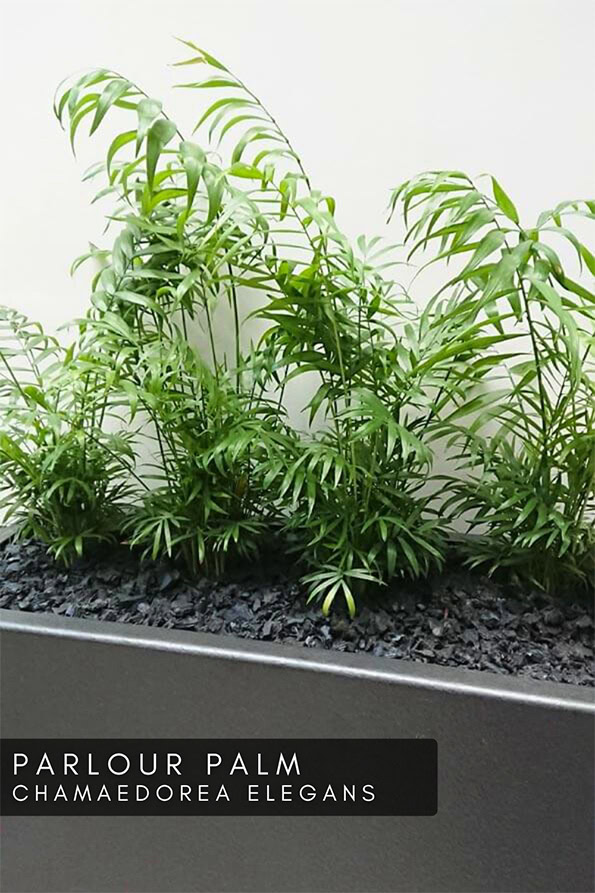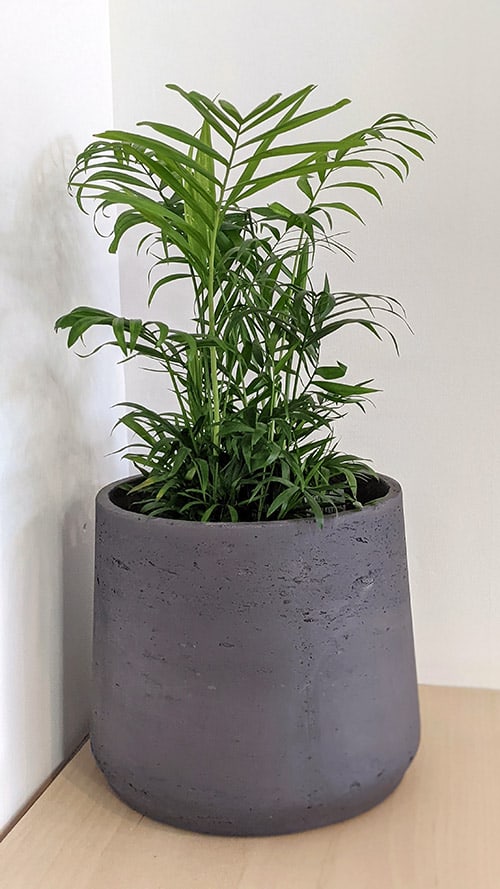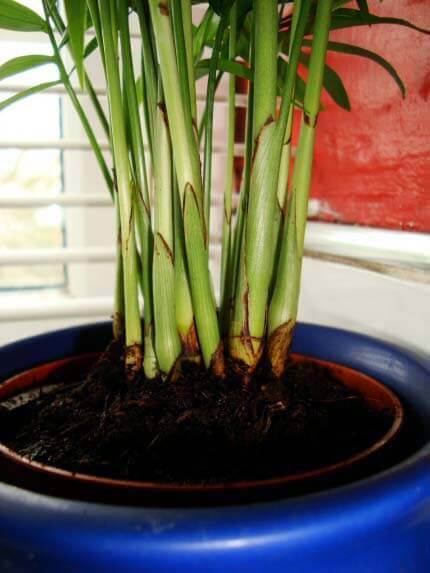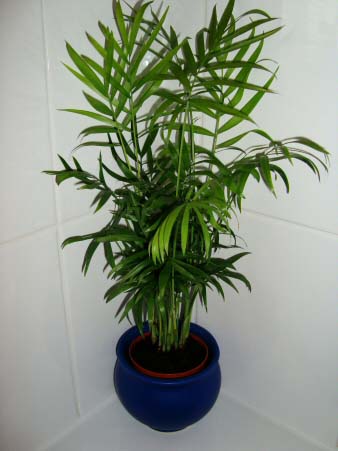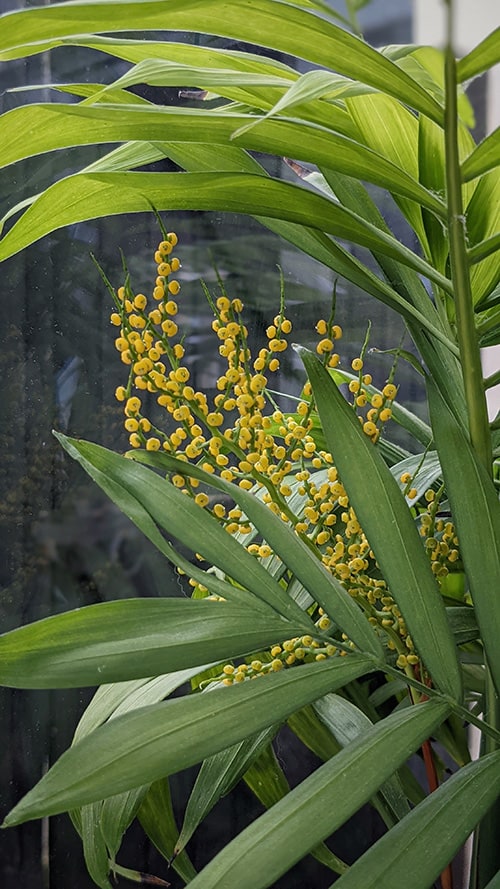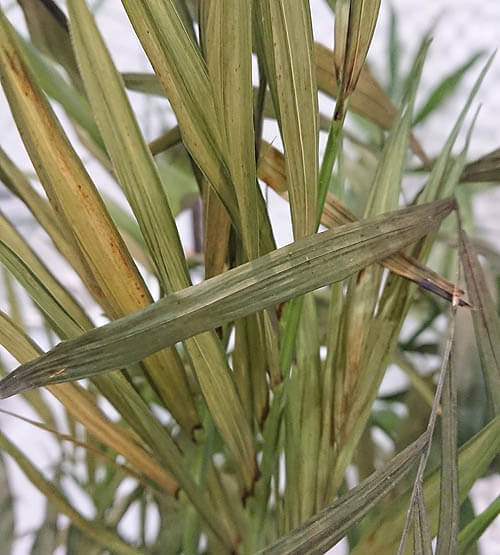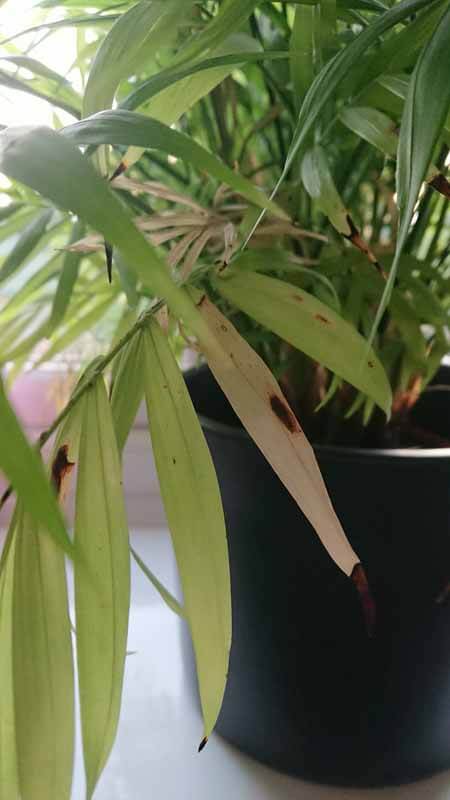The Parlour Palm, or Parlor Palm in America, or by its Latin name of Neanthe bella is one of the most sought after indoor palms around.
The reasons for this couldn't be more straightforward - It thrives in our homes and workplaces where other species may struggle and it's also one of the cheapest palms you can buy.
A number of plants growing in a large rectangular container.
The beautiful, attractive and delicate appearance of the Parlour Palm is made up of light green fronds about 8in / 20cm long that have a dainty like texture which interior designers love.
Whilst a slow grower, it should easily reach a respectable indoor height of 2ft / 60cm after only a few years.
Popular since Victorian times, this was a plant commonly found growing in home Parlors (and that's how it got its common name). The Parlor was often considered the best room in the house and where important guests would be entertained.
Looking back, it makes perfect sense that the Victorians would only try and grow the most hardy and robust looking plants. For minimal care and effort they'd be rewarded with a room enhancing plant.
In modern times it has kept hold of this prestige through its easy going adaptive attitude to low light and humidity levels, all the while being effective at improving air quality and making it onto NASA's list of 50 Indoor plants that clean the air.
This is an equally great plant to start with for the beginner or the seasoned houseplant collector.
This is an elegant and graceful palm that can soften hard edges, including this rough and textured concrete planter.
Whilst a slow grower, it should easily reach a respectable indoor height of 2ft / 60cm after only a few of years, and you may (with good light) receive regular clusters of flowers which for a palm kept indoors is pretty rare.
Did you know?
When searching in the shops, textbooks or other websites, its botanical name may not be listed as Chamaedorea elegans. Instead you may find it going by Collinia elegans or the more popular Neanthe bella.
It's typically sold as a cluster of smaller plants, creating an immediate compact, full and almost bushy appearance which is easy to mistake for a well grown single potted up plant.
Casting your eyes down to where the multiple stems emerge out of the soil will give the game away though!
Ultimately like many palms there's only one cultivar you can generally buy and so providing you can recognise it by sight (look at the pictures throughout this article for that) you will know immediately if you're looking at a true C. elegans or not.
Photo by David J Stang showing the delicate leaf shape.
This is a seriously easy going houseplant. One of my "top ten easy houseplants" for sure. It puts up with a lot and never complains.
It can cope with lots of poor conditions, although don't treat it this way if you want a healthy robust looking plant instead follow the care guide below and give your palm the love it deserves.

Hi, I'm Tom!
If you're like me and enjoy the challenge of growing houseplants and getting them to thrive, then Ourhouseplants can help. This website shares my knowledge and years of growing plants and provides (hopefully) helpful advice on properly caring for your indoor plant friends.
Low light will be tolerated but like all houseplants deep shade or no light at all will not go down well (unless it's only for short periods). Some sun will be helpful, but harsh direct sunshine will scorch the leaves in time.
The perfect spot for your Parlour Palm therefore should be somewhere bright and ideally with a little sun in early morning or late afternoon. Have a read of my Light Guide if you want some further food for thought about placement.
Underwatering a Parlour Palm is better than overwatering. Water well then wait until the surface and inch or so below the soil surface has dried out, at which point water well again. They're forgiving plants and will let you off if you forget to water them on occasion.
Limit the amount of water given when light or temperature levels are low, in those conditions they don't need as much water. Too much wetness around the roots for prolonged periods will encourage fungi and run the risk of root rot which could quickly finish your plant.
To avoid this happening all you need to do is remember to make sure no water is being held in the drip tray or in the container surrounding the pot itself after you've watered it. If there is water sloshing about, simply pour it away.
Red Spider Mite can be an issue if humidity is very low or there is a lot of dry air around the leaves, for example if placed near a working radiator. However, providing Spider Mites aren't a problem in your home this is a palm that really doesn't care too much about humidity.
Because there are often several plants in a single pot all fighting for the limited number of nutrients in the soil, you should look to feed on a semi regular basis.
That said, these palms are still relatively small and don't need masses of feed to do well. A general feed once every couple of months will be enough for mature plants. Younger plants will be happy with slightly more, so aim for once a month.
Come see me over on YouTube showing off my plant.
Warmth is needed for actual growth to occur 20°C (68°F) - 27°C (80°F). A lower temperature is fine as the plant will still survive providing it doesn't dip much below 10°C (50°F), just be aware that slow or no growth might be a symptom of the temperature being too cold.
Palms, in general, don't like regular root disturbance and because they have weak root systems, frequent repotting can be damaging over the long term. Despite this warning, young Parlour Palm plants will often still need to be repotted once a year until they reach a mature size because they will need space to grow.
Only repot mature plants when the potting media breaks down and starts to affect your watering efforts, i.e. the water either constantly drains out leaving the soil dry or it becomes like a sponge and results in a soggy mess. Realistically this is likely to be every two or three years.
Your everyday compost from the garden center is all that is required. But you can use any reasonably free draining mix if you want, just not too free draining as they're moisture fans.
A pot one size bigger is a good idea, but if you prefer it would be fine to just scrape and remove some of the old soil, then replace it with new. When you put the plant in the pot be sure to anchor it in place by packing it fairly tightly around the root ball.
Those stems are packed in tight, but that's how they like it.
A "single" Parlour Palm plant is almost always sold in clusters of several plants close together, as you can see in the photo above.
This means you can look to increase your stock through division. Be warned when you divide a plant, you affect its appearance in a big way, so think carefully before you do it.
Even in a bright light location, if the temperature is warm and you water perfectly, growth is still rather slow. With that said, maturity is reached after only a few years because the ultimate height and spread tends to be on the dwarf size when comparing all the different palms species side by side.
The Chamaedorea is a popular tropical plant sold in many stores. After a few months of owning one you'll hopefully know why (they're very easy!).
In general these are short plants, and few grown indoors will ever be taller than 3ft / 1m, although 6ft / 1.8m specimen plants are not unheard of. The spread will narrow towards the base and become wider as you move upwards.
Small flowers and sometimes even small seeds do appear quite often throughout the year on a mature well grown and well cared for plant.
They don't really smell or look remarkable so if you do get them bloom it probably won't be something you'd be sharing on Instagram. There are some photos from readers in the comments section below, but in the main this houseplant is only grown for the tranquil and lush foliage.
The yellow flowers will often appear during the growing season, provided your plant is receiving decent care.
Like many palms, the Parlour Palm is not poisonous to cats or dogs or people. So it can be enjoyed by you and your four legged friends without worry.
Some houseplants respond really well to some light pruning. You cut off a few shoots and the plant grows several more in its place. However you must never "prune" or cut off healthy green fronds on Palms because they've only one point of growth, which if removed will stop growth on that part in its tracks.
Lower fronds will naturally die and brown over time though and you should cut them off to maintain the overall attractive appearance.
Average Light Levels An adaptable houseplant that can be grown in a bright spot or moderate low light. Avoid direct sun and deep shade.
Medium Watering They like their soil to be moist in Spring, Summer and Fall. On the drier side in Winter.
Average Temperature Provide temperatures between 15°C (59°F) and 27°C (80°F).
Feeding Add feed to the soil once every other month.
Pests.
Palms can attract Red Spider Mites that will take over and weaken your plant over time. Difficult to spot at first, but in time their presence is clear to see with their sticky webs taking over the fronds. Good levels of humidity will help prevent their appearance in the first instance.
This can look like a lot of things, but get your eyes in closer and you'll can see small Thrip insects. You need to resolve them soon as they can do extensive damage.
Parlour Palms are also Thrip magnets. The larvae are very small and easily missed, but despite their size, they have extremely large appetites and will suck the sap and life from your plant over a matter of weeks if you don't stop them. To make things even worse they can spread viruses in the process.
Sort them quickly.
I've only ever lost a few houseplants to pests. But Thrips are another story, they've cleared out and ruined entire rooms of plants. I think they're the worst indoor pest. Get rid of them quickly is my advice.
If allowed to get out of hand your palm will quick take on a very sickly appearance. Mottled, brown, half dried out leaves are all strong signs you have a Thrip problem.
You may waste time thinking its a lighting or watering problem. Before thinking that, please take time to study the leaves and check out my Thrip spotting guide for some more tips.
Large parts are browning and going over.
Unlike other houseplants "leaf drop" doesn't occur in the same way on Parlour Palms, instead what looks like large parts of the plant may brown up. This is okay, normal in fact if it's only happening occasionally, so once fully brown and crispy cut it away.
On the other hand if it is happening on mass you have a problem. Check it over carefully for any pests (especially Thrips which love these Palms, see above for more). If you're pest free assess how you have been treating it during the previous couple of weeks or months. Then going forward, follow my Parlour Palm care instructions section.
Neglect.
There is a lot going on with this neglected plant in the photo below. All the issues you can see (leaves with brown tips, brown spots, and fading leaves) are detailed separately in this section and the cause and solutions explained. All of these things though can be avoided with a decent care routine.
If you neglect your plant it will eventually look washed out and tatty. Prune off the rubbish bits to improve the appearance.
Leaves with brown tips.
Normally this is a sign of very dry air. So it might be an idea to try and increase the humidity to prevent this. Most homes however have a reasonable level of humidity for this not to be an issue anyway (these plants tolerate low humidity more than most).
So if you're getting the brown tips it could be that you're growing your plant in a location with excessively dry air like near a radiator or high up on a shelf. Consider moving it somewhere different.
If you can't, or the problem isn't that bad (no houseplant can look perfect forever, even if you give the best possible care) just leave it where it is. Instead remove the brown tips with a pair of scissors as leaving them will blemish the overall appearance. Take care to only cut off the brown and not into the healthy green parts.
Leaves have brown spots.
In most cases this will have been caused through overwatering or the temperature being too cold around the plant. They could be "spots" or more like "blotches", both type of marks are shown in the photo above, but they're caused by the same thing.
Translucent, fading, less green leaves.
Leaves only have a limited lifespan so eventually older leaves will always start to fail and look strange. Before they go completely brown the plant will remove all the useful parts within the leaf and transfer it to other parts or use it to fuel new growth. This process in some plants is quite rapid, but in palms it can take several weeks or even months.
The color contrast between the affected leaf and a younger one can be quite remarkable, but basically it's normal and not something to be concerned about. However if any of the color has a yellowing shade, then have a look at the final issue below.
Yellow leaves.
This is either caused by allowing the root ball to dry out, (water more frequently). Or the nutrients in the soil have been depleted and the plant is struggling to maintain basic functions.
You will know if it's the latter because it will mean your plant hasn't been fed or repotted for quite some time. The fix is to ideally repot it or start feeding more frequently.
Credit for the Chamaedorea elegans photo near water - Article / Gallery -David Stang.
